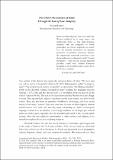The Global Phenomenon of Islam Through the Lens of Late Antiquity
Author(s)
Rabbat, Nasser
DownloadUntitled attachment 00020.pdf (233.9Kb)
Publisher with Creative Commons License
Publisher with Creative Commons License
Creative Commons Attribution
Terms of use
Metadata
Show full item recordAbstract
<jats:p>The global reach of Islam is a poorly theorised historical phenomenon. This essay focuses on the evolving conceptualisation of Late Antiquity as a framework for the inclusion of Islam in a West-oriented, though universally applied, periodisation. My argument, indebted to Garth Fowden, is that Islam came out of late antiquity but brought in “Eastern” epistemologies to the mix in order to construct its own direction at its own pace.
Cover image caption: A segment of the remaining frieze on the facade of the Mshatta Palace near Amman, Jordan, dated to the 740s and ascribed to the Caliph Walid II (743-44). Photo Nasser Rabbat.</jats:p>
Date issued
2021-05-25Department
Massachusetts Institute of Technology. Department of ArchitecturePublisher
Firenze University Press
Citation
Rabbat, Nasser. 2021. "The Global Phenomenon of Islam Through the Lens of Late Antiquity."
Version: Final published version
ISSN
1123-7023